José Ulisses Manzzini Calegaro
Nathalia Araújo de Santana Mota
ABSTRACT
Aim: To evaluate exposure to natural ionizing radiation from monazite sand and breast cancer mortality in Guarapari, state of Espírito Santo, Brazil.
Methodology: This retrospective study compared breast cancer mortality per 100,000 inhabitants in the municipalities of Guarapari (ES), Ilhéus (BA), Campos de Goytacazes (RJ), and Rio Grande (RG), coastal cities with similar socioeconomic profiles and population pyramids. Data from the Brazilian Institute of Geography and Statistics (IBGE) and DATASUS (Ministry of Health) collected between 2002 and 2008 were used. Radiometric surveys were conducted by the Applied Physics Group of UFES for Guarapari, while the other locations followed CNEN recommendations. Statistical analysis considered p≥0.05.
Results: Accumulated natural radiation levels in Guarapari result in doses ranging from 3.65 mSv/year to 10.95 mSv/year, while in other locations, it is 1 mSv/year. The average breast cancer mortality rate between 2002 and 2008 was: Rio Grande = 26.7; Campos = 17.1; Ilhéus = 8.8; and Guarapari = 8.4. This indicates lower incidence of the disease in Guarapari, a fact that contradicts the theory of cancer induction even with low ionizing radiation levels; therefore, it is possible that there is a stimulating effect on the human biological process, resulting in a protective response.
Conclusion: In this approach, the induction of malignant tumors was not confirmed; but the opposite appears to occur: hormesis of breast cancer in Guarapari, the most common tumor among Brazilian women.
Keywords: breast cancer, natural ionizing radiation, hormesis

